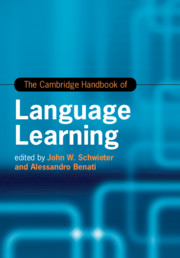Book contents
- The Cambridge Handbook of Language Learning
- Cambridge Handbooks in Language and Linguistics
- The Cambridge Handbook of Language Learning
- Copyright page
- Contents
- Figures
- Tables
- Contributors
- Acknowledgements
- Introduction
- Part I Theories
- Part II Methods
- 5 Qualitative Classroom Methods
- 6 Experimental Studies in L2 Classrooms
- 7 Action Research: Developments, Characteristics, and Future Directions
- 8 Classroom Observation Research
- 9 Psycholinguistic and Neurolinguistic Methods
- Part III Skill Development
- Part IV Individual Differences
- Part V Pedagogical Interventions and Approaches
- Part VI Context and Environment
- Part VII Moving Forward
- Index
- References
9 - Psycholinguistic and Neurolinguistic Methods
from Part II - Methods
Published online by Cambridge University Press: 25 June 2019
- The Cambridge Handbook of Language Learning
- Cambridge Handbooks in Language and Linguistics
- The Cambridge Handbook of Language Learning
- Copyright page
- Contents
- Figures
- Tables
- Contributors
- Acknowledgements
- Introduction
- Part I Theories
- Part II Methods
- 5 Qualitative Classroom Methods
- 6 Experimental Studies in L2 Classrooms
- 7 Action Research: Developments, Characteristics, and Future Directions
- 8 Classroom Observation Research
- 9 Psycholinguistic and Neurolinguistic Methods
- Part III Skill Development
- Part IV Individual Differences
- Part V Pedagogical Interventions and Approaches
- Part VI Context and Environment
- Part VII Moving Forward
- Index
- References
Summary
Language learning involves more than acquiring knowledge of the target language; learners must also be able to put their knowledge to use during real-time processing, and in the past twenty years, sophisticated psycholinguistic and neurolinguistic methods have been employed to allow for a deep investigation into these processes. A number of techniques, such as self-paced reading and cross-modal priming rely on speed responses (for instance a button-push) to infer the underlying comprehension processes that are involved in the real-time processing of linguistic material. Specifically, in comparison to a control condition, a slower response indicates difficulty in, for instance, lexical access, or the processing of ambiguous, complex, or ungrammatical input, at certain points in a sentence. Eye-tracking during reading can also be used to examine lexical and sentence processing in a similar way, but this method can add detail to the study of the comprehension processes via the examination of specific eye-movement measures thought to tap early (first fixations) and later comprehension processes (go-past times and regressions).
- Type
- Chapter
- Information
- The Cambridge Handbook of Language Learning , pp. 208 - 230Publisher: Cambridge University PressPrint publication year: 2019

